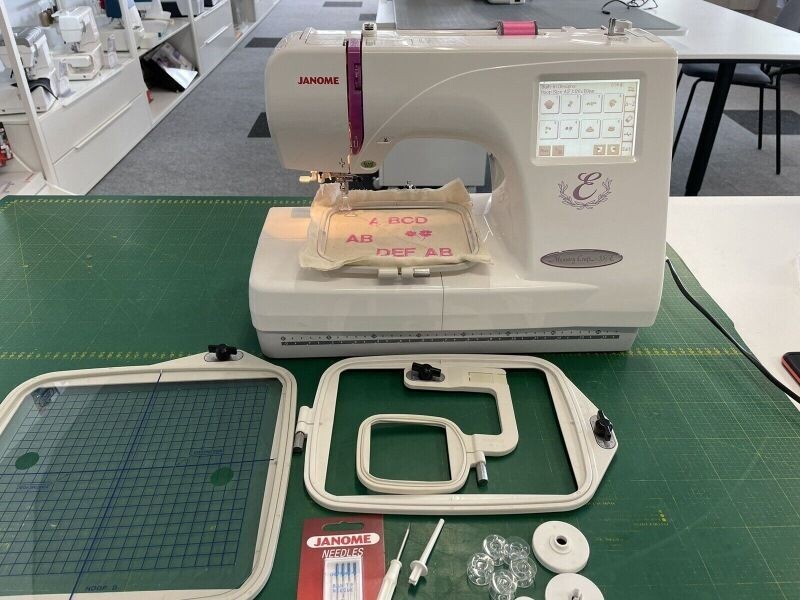
Congrats you have your new embroidery machine and are ready to have your first project, or you’ve been using your machine for a longer while and are wondering what kind of care actions your machine need. How to maintain your embroidery machine, how often your machine needs maintenance action, and why to maintain your machine -all these topics I want to discuss in this post.
Why make your embroidery machine maintenance?
Make embroidery machine maintenance is important for several reasons:
Machine Performance:
Regular maintenance ensures that your embroidery machine operates at its best performance. By keeping it clean, lubricated, and properly adjusted, you can avoid issues such as thread breakage, skipped stitches, or uneven tension. This leads to better stitch quality and more accurate embroidery results.
Machine Longevity:
Proper maintenance helps extend the lifespan of your embroidery machine. By taking care of it and addressing any potential issues promptly, you can prevent major breakdowns and costly repairs. Regular cleaning and lubrication also minimize wear and tear on the machine’s moving parts, preserving its functionality over time.
Stitch Consistency:
Mking embroidery machine maintenance contributes to consistent stitch quality. When the machine is clean, properly threaded, and the tension is correctly set, you can achieve uniform and professional-looking embroidery designs. Neglecting maintenance can result in inconsistent stitches, which can be frustrating and affect the overall appearance of your projects.
Cost Savings:
Investing time in regular maintenance can save you money in the long run. By addressing minor issues early on, you can prevent them from escalating into larger, more expensive problems. Proper maintenance also reduces the need for frequent repairs or part replacements, which can be costly.
Time Efficiency:
A well-maintained embroidery machine is less likely to experience unexpected downtime due to malfunctions or errors. By keeping your machine in good condition, you can minimize interruptions during your embroidery projects and complete them more efficiently.
Warranty Compliance:
Some embroidery machines come with warranties that require regular maintenance to remain valid. By adhering to the manufacturer’s maintenance recommendations, you ensure that you meet the warranty’s conditions and can seek assistance if any major issues arise.
Overall, maintaining your embroidery machine is essential for optimal performance, durability, and cost-effectiveness. By dedicating a little time to regular cleaning, lubrication, and inspection, you can enjoy uninterrupted stitching and achieve excellent embroidery results.
How often do you need to make your embroidery machine maintenance?
Regular maintenance of an embroidery machine is essential to ensure its optimal performance, longevity, and stitch quality. By performing maintenance tasks, you can prevent potential issues, minimize downtime, and extend the machine’s lifespan.
Maintenance should be conducted on a regular basis, depending on factors such as machine usage, project completion, and manufacturer recommendations. Daily maintenance tasks, such as cleaning the machine, removing debris, and inspecting the needle and bobbin area, should be performed after each use. This helps prevent buildup and ensures a clean and functional machine for the next embroidery session.
Additionally, project-based maintenance is recommended after completing a project or a significant amount of stitching. This may involve more thorough cleaning, checking tension, and inspecting the needle and thread quality to ensure they are in optimal condition for the next project.
How to make your embroidery machine maintenance?
Embroidery machines require regular maintenance to ensure their smooth operation and longevity. Here are some important aspects to consider for the daily maintenance of an embroidery machine:
- Cleaning: Regular cleaning is crucial to prevent dust, lint, and debris from accumulating on the machine. Use a soft brush or lint-free cloth to remove any dirt or thread residues from the machine’s surface, bobbin area, needle area, and embroidery hoop.
- Lubrication: Proper lubrication is essential to keep the machine running smoothly. Follow the manufacturer’s instructions to identify the specific points that require lubrication and use the recommended lubricant. Avoid over-lubricating, as it can attract more dirt and cause other issues.
- Bobbin Maintenance: Check the bobbin area regularly to ensure there are no tangles, lint buildup, or broken needles. Clean the bobbin case, remove any lint, and insert a fresh bobbin when necessary. It’s also important to use high-quality bobbins that are compatible with your machine.
- Needle Care: Inspect the needle for any signs of damage or dullness. Replace the needle if it is bent, worn, or broken. It’s recommended to change the needle after every project or after approximately 8-10 hours of continuous stitching. Make sure to use the correct needle type and size for your fabric and thread.
- Thread Tension: Check the thread tension regularly to ensure it is set correctly. Improper tension can result in uneven stitches or thread breakage. Follow the machine’s manual for instructions on adjusting the tension and perform any necessary adjustments.
- Hoop Maintenance: Clean the embroidery hoop after each project to remove any adhesive residue or buildup. Use a mild soap and water solution or a non-abrasive cleaner, and dry it thoroughly before the next use. Inspect the hoop for any signs of damage and replace it if needed.
- Software Updates: If your embroidery machine has software or firmware updates available, ensure you stay up to date with the latest versions. Check the manufacturer’s website or contact their customer support for any available updates and follow the instructions provided.
- Power and Electrical Connections: Regularly check the power cord and electrical connections to ensure they are secure and free from damage. Avoid exposing the machine to moisture or extreme temperatures that could affect its electrical components.
- User Manual: Familiarize yourself with the specific maintenance instructions provided in your machine’s user manual. It contains valuable information tailored to your machine’s model and can guide you on proper maintenance procedures.
Remember to consult the manufacturer’s guidelines and recommendations for your specific embroidery machine model, as maintenance procedures may vary. By following these daily maintenance practices, you can help keep your embroidery machine in optimal condition and ensure high-quality stitching results.

